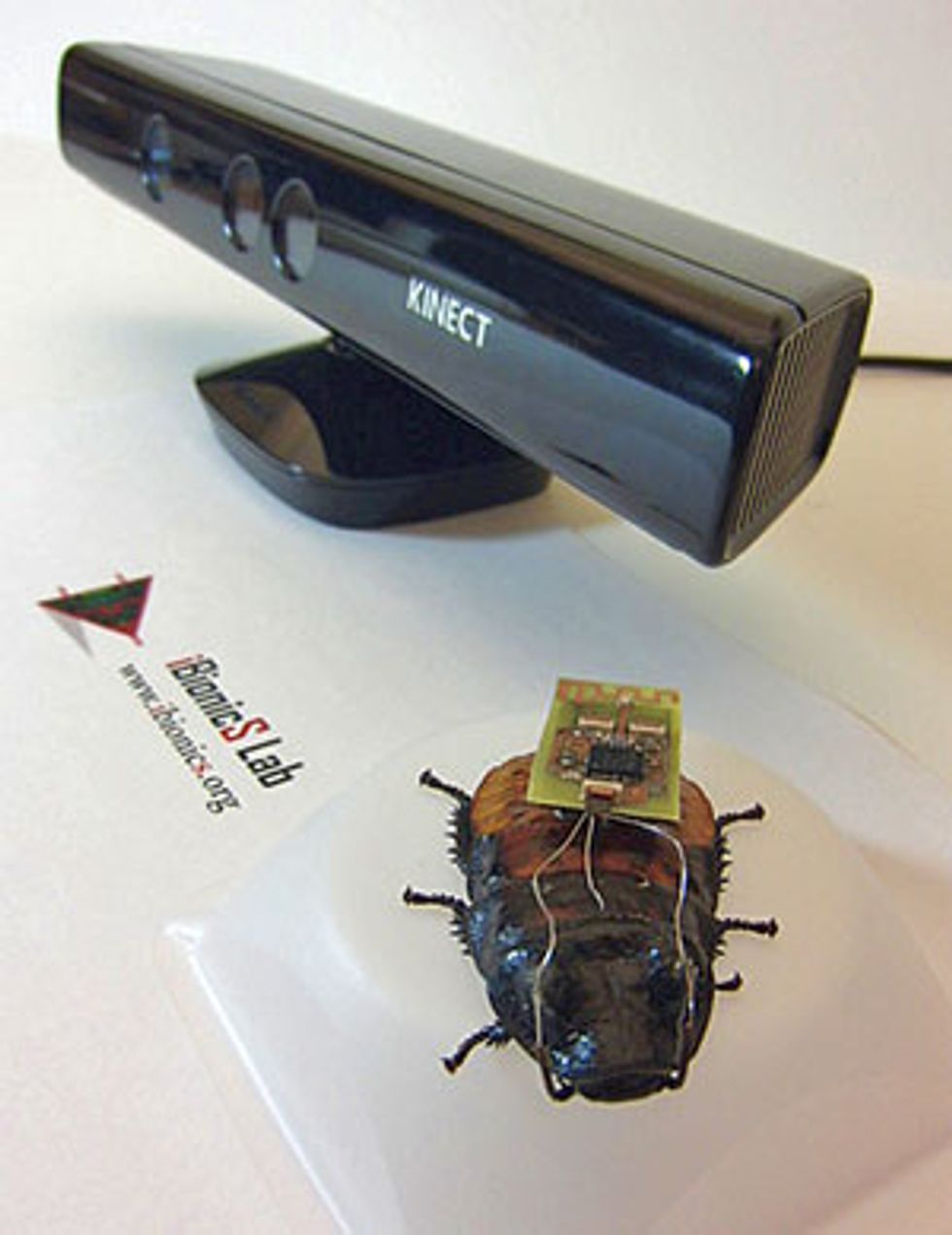Microsoft's Kinect, the motion-sensing system that lets users play Xbox games without a controller, has been repurposed for many a hack, from steering RC cars to Whole Foods shopping carts. Now, researchers at North Carolina State University say they're employing the video game technology to gather information about how best to control a swarm of circuit-equipped cockroaches. Once the system is refined, a troop of these roach biobots could be sent into the wreckage of a collapsed building or an earthquake, in order to save your life.
Late last year, the NC State engineers demonstrated how they could direct a remote-controlled roach through an S-shaped course with a 10 percent success rate. In this iteration of the experiment, the electronic backpacks lugged by the roaches—which take over their movements in a kind of creepy robo-possession—remain the same. But now, each twitch and turn by the bugs through the course is no longer controlled by a human in real-time. Instead, these robo-roaches are on “autopilot,” their paths plotted out by computers.
With the Kinect newly incorporated into the system, control became completely human hands-free. “The Kinect camera sees the location of the insect and [it] knows the path the insect is supposed to follow, which we've drawn on the ground... The camera can detect it visually,” says Bozkurt. The Kinect image processing system is paired with the researchers' own custom computer software, which steers the cockroach. "Pulses are automatically sent to the insect and [the software] can change stimulation parameters to optimize it: amplitude, frequency, what kind of pulse is used," Bozkurt says.
The use of live bugs instead of purely robotic drones in a reconnaissance mission presents some advantages: It saves a lot of battery power and there are no mechanical parts that are prone to fail. Additionally, Bozkurt points out, using a real live cockroach lets humans harness the animal's raw senses and instincts. “In nature, there are a lot of existing dangers for the robotic insect,” he says. “Any obstacle can take them out of their course or unbalance them, so you need to put lots of sensors on them. And the more sensors you put, the harder it is to control size—they become larger and larger.”
During each roach run, the circuit-saddled insect lurches around a U-shaped path of 13 waypoints on a 90 x 90 cm2 test bed in clockwise, then counterclockwise, directions. The computer vision software can precisely track and measure the roaches' responses to electrical impulses in a repeatable testing environment.
Out of approximately 100 trials using four different insects, twenty-seven trials saw the roach hit 11 of the 13 waypoints. Ten of these successful trials were further analyzed, and preliminary data indicated patterns in the reaction time of the roach, its angular velocity, and the angle measurement of each turn. “The study was about technology platform demonstration,” says Bozkurt. “The most important outcome of this was that even if we take the human related inaccuracies and variances, we observe a statistical distribution... Insects respond to our stimuli similarly, but not exactly the same way.”
The reason for the roaches' varied responses, according to Bozkurt, could be due to environmental factors. These include the time of day when the trial was conducted, time since the surgical insertion, level of lighting, and proximity to the walls of the testbed. “The platform will help us to find out the reason behind the variances in these numbers by isolating different factors during our experiments,” he says.
The researchers also admit the success rate could be improved, but assert that their platform demonstrates a way to quantitatively analyze insect stimulation response; previous efforts could only measure this subjectively. Moreover, the researchers say, the platform they've built will pave the way for the success rate to improve quickly and dramatically.
“Twenty-seven of 100 is our initial number without optimizing any stimulation parameters and we are expecting it to increase rapidly with optimizations thanks to this platform,” says Bozkurt.
But even without these optimizations, he says, there is a solution. Like other insect engineers, Bozkurt is a firm believer in the effectiveness of the swarm. “From an application standpoint, we can perform a hundred insertions in around two to three hours. This statistically gives us around twenty to thirty insect biobots functioning properly without further optimization,” he says. “Even at this stage, we can use these for successful biobotic mission accomplishment. Given the simplicity of the surgery and the low cost of the materials and insects, this is still an efficient method for the future of the biobots.”
Other research groups are looking to take advantage of the swarm as well. Last month at the Symposia on VLSI Technology and Circuits in Japan, Purdue University researchers showed off a smartly engineered low-power wireless transceiver for insect-based sensor networks. Their cockroaches are not wired for steering, but Benjamin Epstein, vice president of special projects at systems and networking company OpCoast, in Brick, N.J., told IEEE Spectrum that releasing swarms of cockroaches means "statistically, some of them will go where we want them to go."
Photo: Alper Bozkurt




